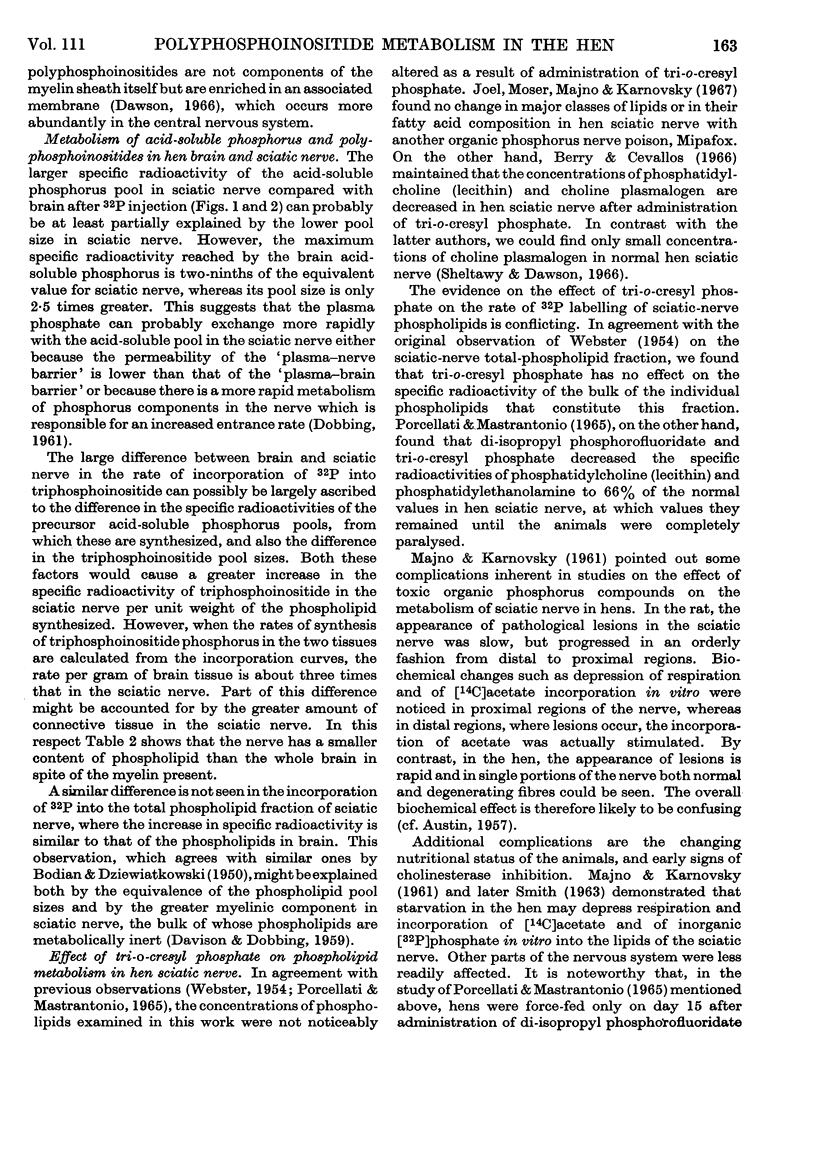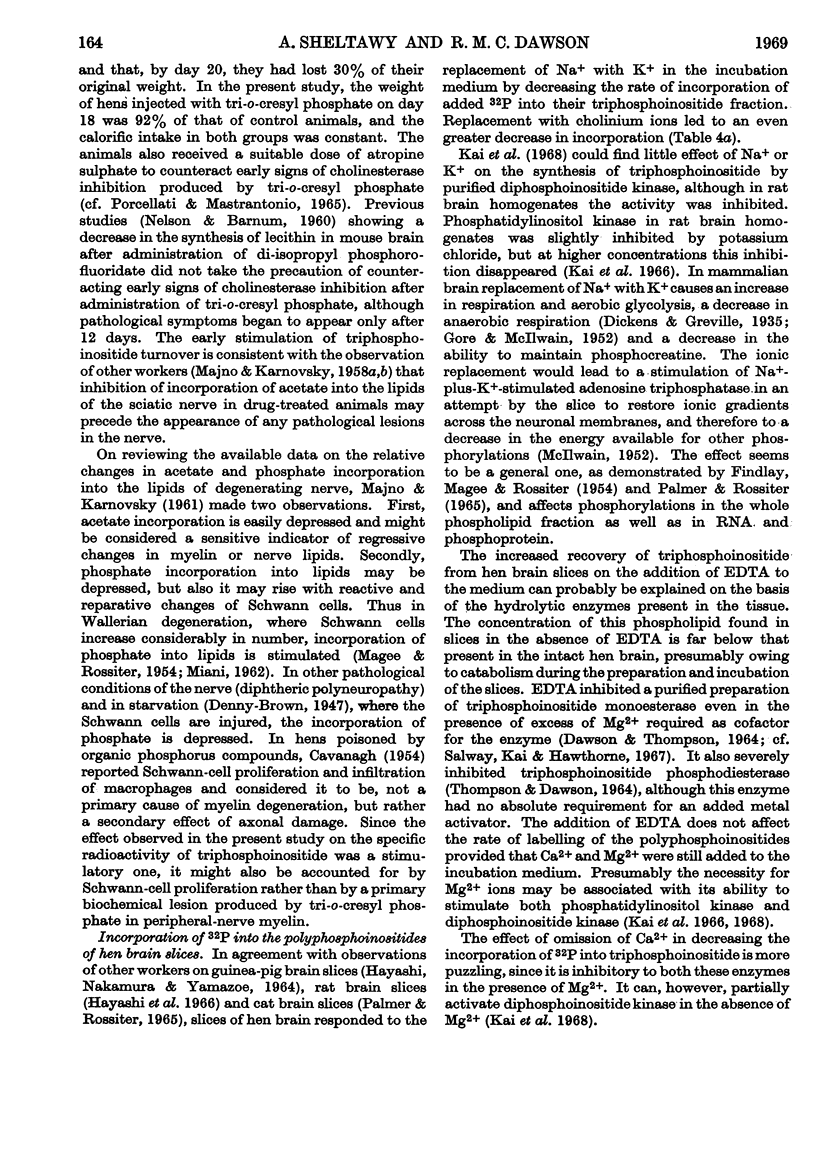Abstract
1. The distribution of individual phospholipids was determined in hen brain and compared with that in sciatic nerve obtained in a previous investigation. Sciatic nerve is more enriched in the myelinic phospholipids ethanolamine plasmalogen, phosphatidylserine and sphingomyelin, but it contains relatively less triphosphoinositide, and much less diphosphoinositide, than the brain. 2. The course of incorporation of intraperitoneally injected 32P into the acid-soluble phosphorus, phosphoinositides and total phospholipids of hen brain and sciatic nerve was followed. Although the maximum specific radioactivity in sciatic nerve of acid-soluble phosphorus is 4·5 times, and that of triphosphoinositide six times, that in the brain, the relative rate of triphosphoinositide phosphorus synthesis per gram of brain is three times that in sciatic nerve. 3. Administration of the demyelinating agent tri-o-cresyl phosphate to hens has no significant effect on the amounts or the rate of 32P incorporation into the total phospholipids of the sciatic nerve. However, the rate of incorporation of 32P into triphosphoinositide, although not its concentration, is raised from the first day after administration of the drug and remains thus 13 and 23 days later. 4. The incorporation of 32P into polyphosphoinositides of hen brain slices in vitro was studied. The recovery of triphosphoinositide from the slices is markedly increased in the presence of EDTA, although the rate of incorporation of 32P is unaffected. The incorporation of 32P is dependent on the presence of Mg2+ and Ca2+ in the medium, and is decreased when Na+ is replaced with K+ or cholinium ions.
Full text
PDF








Selected References
These references are in PubMed. This may not be the complete list of references from this article.
- AUSTIN L. Lipid biosynthesis and chemically induced paralysis in the chicken. Br J Pharmacol Chemother. 1957 Sep;12(3):356–360. doi: 10.1111/j.1476-5381.1957.tb00148.x. [DOI] [PMC free article] [PubMed] [Google Scholar]
- BODIAN D., DZIEWIATKOWSKI D. The disposition of radioactive phosphorus in normal, as compared with regenerating and degenerating nervous tissue. J Cell Physiol. 1950 Apr;35(2):155–177. doi: 10.1002/jcp.1030350202. [DOI] [PubMed] [Google Scholar]
- Berry J. F., Cevallos W. H. Lipid class and fatty acid composition of peripheral nerve from normal and organophosphorus-poisoned chickens. J Neurochem. 1966 Feb;13(2):117–124. doi: 10.1111/j.1471-4159.1966.tb03339.x. [DOI] [PubMed] [Google Scholar]
- CAVANAGH J. B. The toxic effects of triortho-cresyl phosphate on the nervous system; an experimental study in hens. J Neurol Neurosurg Psychiatry. 1954 Aug;17(3):163–172. doi: 10.1136/jnnp.17.3.163. [DOI] [PMC free article] [PubMed] [Google Scholar]
- Colodzin M., Kennedy E. P. Biosynthesis of diphosphoinositide in brain. J Biol Chem. 1965 Oct;240(10):3771–3780. [PubMed] [Google Scholar]
- DAVISON A. N., DOBBING J. Phospholipid metabolism in nervous tissue. I. A reconsideration of brain and peripheral-nerve phospholipid metabolism in vivo. Biochem J. 1959 Dec;73:701–706. doi: 10.1042/bj0730701. [DOI] [PMC free article] [PubMed] [Google Scholar]
- DAWSON R. M., HEMINGTON N., DAVENPORT J. B. Improvements in the method of determining individual phospholipids in a complex mixture by successive chemical hydrolyses. Biochem J. 1962 Sep;84:497–501. doi: 10.1042/bj0840497. [DOI] [PMC free article] [PubMed] [Google Scholar]
- DOBBING J. The blood-brain barrier. Physiol Rev. 1961 Jan;41:130–188. doi: 10.1152/physrev.1961.41.1.130. [DOI] [PubMed] [Google Scholar]
- Dawson R. M., Thompson W. The triphosphoinositide phosphomonoesterase of brain tissue. Biochem J. 1964 May;91(2):244–250. doi: 10.1042/bj0910244. [DOI] [PMC free article] [PubMed] [Google Scholar]
- Dickens F., Greville G. D. The metabolism of normal and tumour tissue: Neutral salt effects. Biochem J. 1935 Jun;29(6):1468–1483. doi: 10.1042/bj0291468. [DOI] [PMC free article] [PubMed] [Google Scholar]
- Dodge J. T., Phillips G. B. Autoxidation as a cause of altered lipid distribution in extracts from human red cells. J Lipid Res. 1966 May;7(3):387–395. [PubMed] [Google Scholar]
- Eichberg J., Dawson R. M. Polyphosphoinositides in myelin. Biochem J. 1965 Sep;96(3):644–650. doi: 10.1042/bj0960644. [DOI] [PMC free article] [PubMed] [Google Scholar]
- Evans M. J., Finean J. B. The lipid composition of myelin from brain and peripheral nerve. J Neurochem. 1965 Aug;12(8):729–734. doi: 10.1111/j.1471-4159.1965.tb06787.x. [DOI] [PubMed] [Google Scholar]
- FINDLAY M., MAGEE W. L., ROSSITER R. J. Incorporation of radioactive phosphate into lipids and pentosenucleic acid of cat brain slices; the effect of inorganic ions. Biochem J. 1954 Oct;58(2):236–243. doi: 10.1042/bj0580236. [DOI] [PMC free article] [PubMed] [Google Scholar]
- GORE M. B. R., MCILWAIN H. Effects of some inorganic salts on the metabolic response of sections of mammalian cerebral cortex to electrical stimulation. J Physiol. 1952 Aug;117(4):471–483. doi: 10.1113/jphysiol.1952.sp004761. [DOI] [PMC free article] [PubMed] [Google Scholar]
- Joel C. D., Moser H. W., Majno G., Karnovsky M. L. Effects of bis-(monoisopropylamino)-fluorophosphine oxide (Mipafox) and of starvation on the lipids in the nervous system of the hen. J Neurochem. 1967 May;14(5):479–488. doi: 10.1111/j.1471-4159.1967.tb09547.x. [DOI] [PubMed] [Google Scholar]
- KREPS E. M., NANUKIAN K. G., PATRIKEEVA M. V., SMIRNOV A. A., CHENYKAEVA E. Iu. FOSFOLIPIDY SUBKLETOCHNYKH CHASTITS MOZGA KUR. Biokhimiia. 1964 Nov-Dec;29:1111–1118. [PubMed] [Google Scholar]
- Kai M., Hawthorne J. N. Incorporation of injected [32P] phosphate into the phosphoinositides of subcellular fractions from young rat brain. Biochem J. 1966 Jan;98(1):62–67. doi: 10.1042/bj0980062. [DOI] [PMC free article] [PubMed] [Google Scholar]
- Kai M., Salway J. G., Hawthorne J. N. The diphosphoinositide kinase of rat brain. Biochem J. 1968 Feb;106(4):791–801. doi: 10.1042/bj1060791. [DOI] [PMC free article] [PubMed] [Google Scholar]
- Kai M., White G. L., Hawthorne J. N. The phosphatidylinositol kinase of rat brain. Biochem J. 1966 Nov;101(2):328–337. doi: 10.1042/bj1010328. [DOI] [PMC free article] [PubMed] [Google Scholar]
- MAGEE W. L., ROSSITER R. J. Chemical studies of peripheral nerve during wallerian degeneration. VI. Incorporation of radioactive phosphate into pentosenucleic acid and phospholipin in vitro. Biochem J. 1954 Oct;58(2):243–249. doi: 10.1042/bj0580243. [DOI] [PMC free article] [PubMed] [Google Scholar]
- MAJNO G., KARNOVSKY M. L. A biochemical and morphologic study of myelination and demyelination. I. Lipide biosynthesis in vitro by normal nervous tissue. J Exp Med. 1958 Apr 1;107(4):475–496. doi: 10.1084/jem.107.4.475. [DOI] [PMC free article] [PubMed] [Google Scholar]
- MAJNO G., KARNOVSKY M. L. A biochemical and morphologic study of myelination and demyelination. III. Effect of an organo-phosphorus compound (Mipafox) on the biosynthesis of lipid by nervous tissue of rats and hens. J Neurochem. 1961 Oct;8:1–16. doi: 10.1111/j.1471-4159.1961.tb13521.x. [DOI] [PubMed] [Google Scholar]
- MCILWAIN H. Phosphates of brain during in vitro metabolism: effects of oxygen, glucose, glutamate, glutamine, and calcium and potassium salts. Biochem J. 1952 Oct;52(2):289–295. doi: 10.1042/bj0520289. [DOI] [PMC free article] [PubMed] [Google Scholar]
- MCILWAIN H. Techniques in tissue metabolism. 5. Chopping and slicing tissue samples. Biochem J. 1961 Jan;78:213–218. doi: 10.1042/bj0780213. [DOI] [PMC free article] [PubMed] [Google Scholar]
- MIANI N. The relationship between axon and Schwann cell. Phospholipid metabolism of degenerating and regenerating peroneal-tibial nerves of the rabbit in vitro. J Neurochem. 1962 Sep-Oct;9:525–536. doi: 10.1111/j.1471-4159.1962.tb04206.x. [DOI] [PubMed] [Google Scholar]
- NELSON W. L., BARNUM C. P. The effect of diisopropylphos-phorofluoridate (DFP) on mouse brain phosphorus metabolism. J Neurochem. 1960 Aug;6:43–50. doi: 10.1111/j.1471-4159.1960.tb13447.x. [DOI] [PubMed] [Google Scholar]
- Palmer F. B., Rossiter R. J. A simple procedure for the study of inositol phosphatides in cat brain slices. Can J Biochem. 1965 Jun;43(6):671–683. doi: 10.1139/o65-078. [DOI] [PubMed] [Google Scholar]
- SMITH M. E. THE EFFECT OF FASTING ON LIPID METABOLISM OF THE CENTRAL NERVOUS SYSTEM OF THE RAT. J Neurochem. 1963 Jul;10:531–536. doi: 10.1111/j.1471-4159.1963.tb09856.x. [DOI] [PubMed] [Google Scholar]
- Salway J. G., Kai M., Hawthorne J. N. Triphosphoinositide phosphomonoesterase activity in nerve cellbodies, neuroglia and subcellular fractions from whole rat brain. J Neurochem. 1967 Oct;14(10):1013–1024. doi: 10.1111/j.1471-4159.1967.tb09512.x. [DOI] [PubMed] [Google Scholar]
- Sheltawy A., Dawson R. M. The deposition and metabolism of polyphosphoinositides in rat and guinea-pig brain during development. Biochem J. 1969 Jan;111(2):147–154. doi: 10.1042/bj1110147. [DOI] [PMC free article] [PubMed] [Google Scholar]
- Sheltawy A., Dawson R. M. The polyphosphoinositides and other lipids of peripheral nerves. Biochem J. 1966 Jul;100(1):12–18. doi: 10.1042/bj1000012. [DOI] [PMC free article] [PubMed] [Google Scholar]
- Siek T. J., Newburgh R. W. Phospholipid composition of chick brain during development. J Lipid Res. 1965 Oct;6(4):552–555. [PubMed] [Google Scholar]
- Thompson W., Dawson R. M. The triphosphoinositide phosphodiesterase of brain tissue. Biochem J. 1964 May;91(2):237–243. doi: 10.1042/bj0910237. [DOI] [PMC free article] [PubMed] [Google Scholar]
- WEBSTER G. R. The distribution and metabolism of phosphorus compounds in normal and demyelinating nervous tissue of the chicken. Biochem J. 1954 May;57(1):153–158. doi: 10.1042/bj0570153. [DOI] [PMC free article] [PubMed] [Google Scholar]


